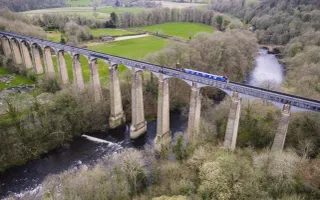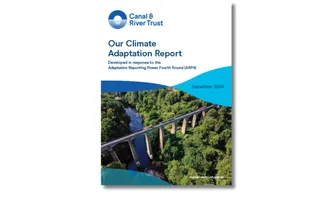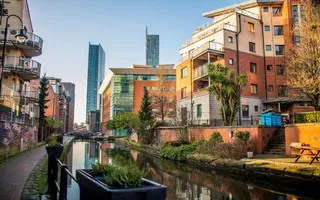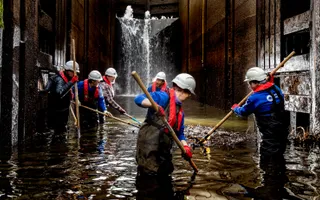We've submitted our first Climate Adaptation Report, putting us amongst the major infrastructure providers that report to Government about managing climate risk.
Canals to form part of UK Government's response to climate change
The government is officially highlighting the role of our centuries-old canal network in responding to climate change.

Making the Industrial Revolution possible
The canal network was the most important infrastructure project of its day, making the Industrial Revolution possible. A legacy of that pioneering engineering, today’s navigable canals continue to be repurposed and are at the heart of many communities, providing a range of economic, social and environmental benefits on the doorstep of around ten million people.
The places around canals have also changed beyond recognition and continue to be a focus for development and regeneration, making the canal network an enabler for growth. Meanwhile, the canals themselves are vital conduits for critical national infrastructure including pipes and cables for the UK’s energy, telecommunications and water supply networks.
But, with most of the canal network built more than 200 years ago, we report that whilst the network has a vital role to play in mitigating climate change it is also vulnerable to the changes in climate and extreme weather events of the 21st century.
The Climate Adaption Report
The Climate Adaptation Report provides evidence into how climate change affects the canal network and its associated structures and habitats, now and in the future. It shares the top 12 biggest risks, including flooding, drought, subsidence, structural damage and ecological degradation, and describes how we manage them, illustrated by case studies.
In helping to mitigate the impacts of climate change, the Report shows how, for example, the canal network could deliver more water to areas that will experience significant water deficit in the years to come and, during storms, how canals will move flash floods away to reduce risk to neighbouring properties. In towns and cities, canals will mitigate urban heat island effects, lowering temperatures and improving quality of life, while the canal network protects many households, businesses and national infrastructure such as electricity sub-stations, transport and schools.
Keeping them open and available
Richard Parry, our chief executive, said: “Our historic canal network fulfils a range of uses far beyond what was anticipated when the canals were first dug by hand. Many people don’t realise that these manmade waterways carry out so many important functions and need constant care and maintenance to keep them open and available to all.
“Linking towns and cities across the country and on the doorstep of millions of people, it is important for canals to be part of Government’s national climate change reporting framework. The challenge of keeping this network resilient and safe in the face of rising climate impact will require ongoing investment but it will deliver many times more benefit to society as we collectively face this unprecedented challenge.”
We're currently running our first fundraising campaign that directly responds to the rising cost of repairing storm and flood damage. Last winter alone, a succession of ‘named’ storms caused almost £10 million of additional and unforeseen repairs. This winter, Storms Bert and Darragh have already caused costly damage, while away from the Trust’s canal network a major breach on New Year’s Day of the privately-owned Bridgewater Canal illustrates the pressure that such old infrastructure is under in the face of climate change.
Richard continued: “The recent storms and floods show just how vulnerable canals, and surrounding communities, can be, and how vital it is to keep them safe. Our charity is calling on the public to help us respond to this threat and make a vital contribution towards maintaining the canal network, ensuring people can continue to use and enjoy the canals for generations to come.”
Protect, operate and manage
Our network includes 2,000 miles of waterways, 82 reservoirs (of which 71 are large, raised reservoirs subject to the Reservoirs Act 1975), four inland ports and over 10,000 principal assets, made up of bridges, aqueducts, tunnels, embankments, a tidal barrage and nationally and internationally designated wildlife sites.
Our core activities are to protect, operate and manage the canal network in England and Wales for navigation, access along the towpaths, and to provide recreation and other leisure activities. Beyond this, the canal network also provides essential services for others, including:
- Water transfer & supply: sustainable water transfers through partnerships with water companies, securing drinking water needs and other water dependent services, while reducing the UK’s need for new reservoirs to be constructed.
- Agricultural support: the canal network provides surplus water to farmers, aiding drought resilience and securing water supplies that are essential for sustaining agriculture.
- Flood mitigation & relief: an adaptable resource to mitigate extreme weather impacts and divert water away from heavily affected areas.
- Heating & cooling: low-carbon heating and cooling of buildings and other infrastructure, such as data centres.
- Firefighting: the emergency services use water from the canal network through agreed abstraction licences or direct use in emergency situations.
- Growth & regeneration: attractive settings for sustainable urban living, active travel and urban cooling in our cities.
Last Edited: 7 February 2025


Stay connected
Sign up to our newsletter and discover how we protect canals and help nature thrive




